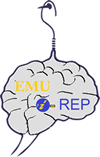JavaScript is disabled for your browser. Some features of this site may not work without it.
| dc.contributor.author | Sultanzade, Vugar | |
| dc.date.accessioned | 2016-04-11T06:51:10Z | |
| dc.date.available | 2016-04-11T06:51:10Z | |
| dc.date.issued | 2013 | |
| dc.identifier.citation | Sultanzade, V. (2013), “Uşun Koca Oğlu’nun Kaç Kardeşi Vardı? (Dede Korkut Kitabı’ndaki Bir Kelime Üzerine)”, Milli Folklor, 100: 149-153. | en_US |
| dc.identifier.issn | 1300-3984 | |
| dc.identifier.uri | http://hdl.handle.net/11129/2422 | |
| dc.description | The file in this item is the publisher version (published version) of the article. | en_US |
| dc.description.abstract | The Story of How Basat Killed Cyclop is located in the Dresden manuscript of The Book of Dede Qorqud. In one place of the manuscript (Dres. 111a: 11), the word written by the letters elif, kef, ye has generally been read as iki ‘two’ by the researchers and translated into other languages in this meaning; for example: “Uşun Ḳoca oğlı kibi pehlivan elinde şehid oldı. Aruḳ candan iki ḳarındaşı Depegöz elinde helāk oldı” (Ergin 1989: 208); “So valiant a man as the son of Ushun Koja died by his hand. His two pure-soulded brothers perished at his hand” (Lewis 1974: 142). Such a reading presents Ushun Koja as if he had three sons, however, this is in contradiction with the facts of The Story of Segrek, Son of Ushun Koja. As it is known from The Story of Segrek, Ushun Koja had just two sons. Consequently, the use of a phrase like iki ḳarındaşı ‘two brothers’ in the above-mentioned fragment wouldn’t be correct from the point of the wholeness of the epos and the logical relations between its stories. A different reading of the word in question is suggested in the article and the reasons of this are brought up. | en_US |
| dc.description.abstract | Basat Depegözi Öldürdügi Boy, Dede Korkut Kitabı’nın Dresden nüshasında yer almaktadır. Yazmanın bir yerinde (Dres. 111a: 11) elif, kef, ye harfleri ile yazılmış bir kelime, araştırmacılar tarafından genellikle iki olarak okunmuş ve başka dillere de bu anlamda çevrilmiştir: “Uşun Ḳoca oğlı kibi pehlivan elinde şehid oldı. Aruḳ candan iki ḳarındaşı Depegöz elinde helāk oldı” (Ergin 1989: 208); “So valiant a man as the son of Ushun Koja died by his hand. His two pure-soulded brothers perished at his hand” (Lewis 1974: 142). Ancak böyle bir okuma, Uşun Koca’nın üç oğlu varmış anlamına gelir, hâlbuki bu, doğrudan Uşun Koca’nın oğullarının macerasından bahseden Uşun Koca Oğlı Segrek Boyu’ndaki bilgilerle çelişmektedir. Bu boyda Uşun Koca Oğlu Segrek’in, Kara Tekür kâfirleri tarafından uzun yıllar önce esir edilmiş ağabeyi Egrek’i kurtarması anlatılmaktadır. Burada Uşun Koca’nın hiçbir zaman Egrek ile Segrek dışında üçüncü bir oğlunun bulunmadığı, ömrinde kelimesi kullanılarak kesin bir dille ifade edilmiştir: “Oğuz zamanında Uşun Koca derler bir kişi varıdı. Ömrinde iki oğlı varıdı” Demek ki, söz konusu parçada iki ḳarındaşı gibi bir ifadenin kullanılması destanın bütünlüğü ve boylar arasındaki ilişki açısından doğru olmazdı. Makalede elif, kef, ye harfleri ile yazılmış kelimenin farklı bir şekilde okunuşu önerilmekte ve bunun gerekçeleri ortaya konmaktadır. | en_US |
| dc.language.iso | tur | en_US |
| dc.publisher | Milli Folklor Dergisi | en_US |
| dc.rights | info:eu-repo/semantics/openAccess | en_US |
| dc.subject | Dede Korkut Kitabı | en_US |
| dc.subject | Uşun Koca Oğlu | en_US |
| dc.subject | Transkripsiyon | en_US |
| dc.subject | The Book of Dede Qorqud | en_US |
| dc.subject | The Son of Ushun Koja | en_US |
| dc.subject | Transcription | en_US |
| dc.title | How Many Brothers Had the Son of Ushun Koja? (On a word in The Book of Dede Qorqud) | en_US |
| dc.type | article | en_US |
| dc.relation.journal | Milli Folklor | en_US |
| dc.contributor.department | Eastern Mediterranean University, Faculty of Education, Department of Turkish Language Teaching | en_US |
| dc.contributor.authorID | TR217144 | en_US |
| dc.identifier.issue | 100 | en_US |
| dc.identifier.startpage | 149 | en_US |
| dc.identifier.endpage | 153 | en_US |









